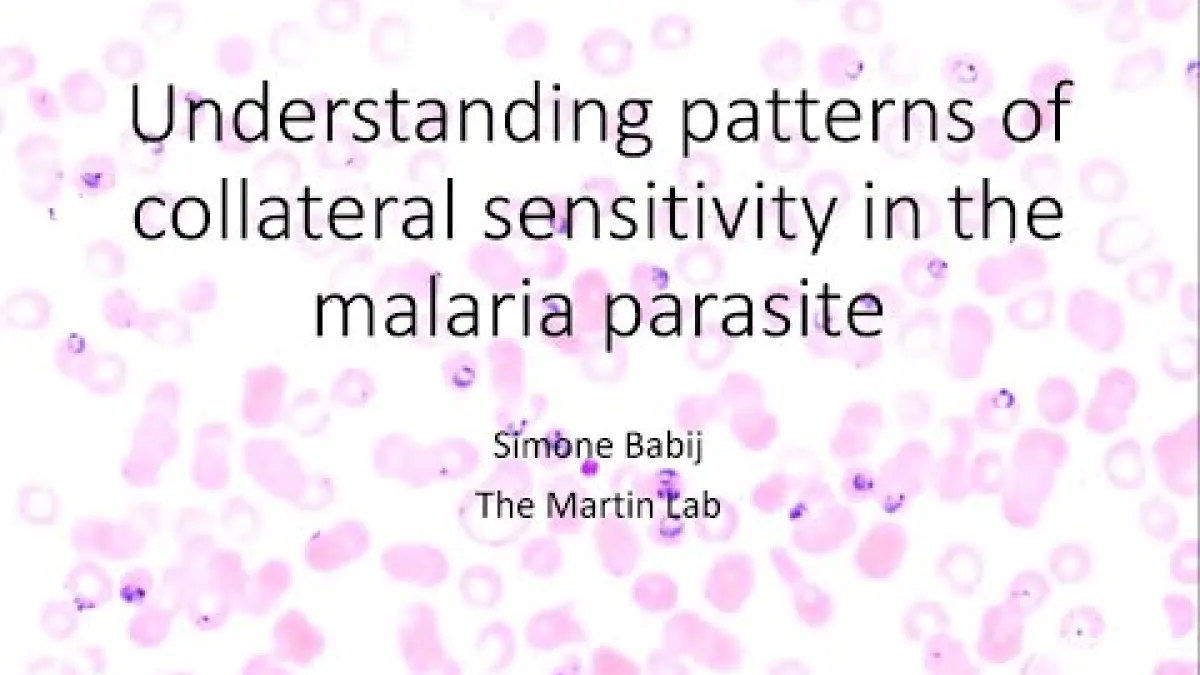BSB MPhil Exit Seminar: Understanding patterns of collateral sensitivity in the malaria parasite
Malaria kills around 400,000 people each year and the prevention and treatment of this disease is highly reliant on chemotherapy.
Speakers
Event series
Content navigation
Description

Abstract
Malaria kills around 400,000 people each year and the prevention and treatment of this disease is highly reliant on chemotherapy. Mutations in the Plasmodium falciparum ‘chloroquine resistance transporter’ (PfCRT) give rise to resistance to the antimalarial ‘wonder-drug’ chloroquine and other quinolines. Studies have found that certain compounds, such as verapamil, re-sensitise the parasite to chloroquine. In the future, such compounds might enable the reuse of chloroquine as an antimalarial. In vitro studies also show that chloroquine resistance-associated isoforms of PfCRT (e.g. PfCRTDd2, PfCRTEcu1110, PfCRT7G8) cause the parasite to become hypersensitive to antimalarials such as lumefantrine and a set of antiplasmodial quinine dimers. This phenomenon, where resistance to one drug induces hypersensitivity to another drug, is known as ‘collateral sensitivity’. It is believed that this collateral sensitivity could be exploited to delay or prevent the emergence of resistance to antimalarials.
The overarching aim of this project was to compare the abilities of different clinically relevant isoforms of PfCRT to bind and transport a number of quinoline homodimers and benzhydryl-based compounds.
The Xenopus oocyte system was used to test a range of benzhydryl-based compounds for their ability to inhibit transport of chloroquine via PfCRTDd2 to screen for compounds with a potential activity against chloroquine-resistant parasites. The extent to which the different compounds inhibited chloroquine transport varied. It was found that two chemical groups -the 4-aminoquinoline and the piperazine moiety - were the most important for creating a strong inhibitor. Compounds NF2322 (quinoline-benzhydryl-based) and NF2386 (triazolopyridine-benzhydryl-based) reduced chloroquine transport by PfCRTDd2 to below 20% of control levels.
The Xenopus oocyte system was also used to investigate a set of quinine and hydroxychloroquine homodimers for their ability to interact with PfCRTEcu1110. All the homodimers significantly reduced chloroquine transport by PfCRTEcu1110. It appeared that an increase in the chemical tether length that joins the two hydroxychloroquine moieties together increased the ability of the homodimer to inhibit chloroquine transport.
Parasite proliferation assays with a set of isogenic pfcrt transfectant lines (expressing either wild-type, Dd2 or 7G8 PfCRT) and clinically relevant strains were carried out to test the homodimers for cross-resistance to chloroquine. These assays revealed that the hydroxychloroquine homodimers share cross-resistance with chloroquine. Measurements of H+ efflux from the parasite’s digestive vacuole in the presence of the compounds suggested that these homodimers were substrates of PfCRTDd2 and PfCRT7G8. The second-generation quinine homodimers were more active against the chloroquine-resistant parasites compared to the chloroquine-sensitive parasites. The QN homodimer QooNH was found to be the most effective at killing chloroquine-resistant parasites. The quinine homodimers did not show evidence of being substrates of PfCRTDd2 and PfCRT7G8, and were found to inhibit a saquinavir (a peptide mimic) induced leak of H+, suggesting that they inhibit the transport of PfCRT’s natural substrate.
This research has resulted in an increased understanding of PfCRT’s substrate-binding capacity and its transport properties. The mechanism by which ‘collateral sensitivity’ occurs to quinine homodimers was also investigated and found to possibly be attributable to inhibition of the transport of PfCRT’s natural substrate. These findings could, in turn, contribute towards the repurposing of old antimalarials to treat drug-resistant forms of malaria by re-sensitising the parasite to these to drugs (such as chloroquine) through the rational design of new homodimers and benzhydryl-based compounds.
Location
This seminar will be held via Zoom only.
Please click the link below to join the webinar:
https://anu.zoom.us/j/88556455033?pwd=ZHN6UWU3UjlsaFRyeXlUb0dXbEQ1dz09
Webinar ID: 885 5645 5033
Passcode: 913339
Canberra time: please check your local time & date if you are watching from elsewhere.

